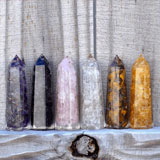Morrisonite Jasper Properties, Uses, Health Benefits
Introduction
Morrisonite is a kind of stone that has many properties and uses. It is also known as the "American Jade". This stone is used in jewelry making and sculptures. It can be found in Utah and California. The color of this stone ranges from light green to dark green, with some shades of browns or grays mixed in.
Color
Morrisonite is a kind of stone that has many properties and uses. It is a jasper, a type of opaque chalcedony. Morrisonite jasper is a brownish-red to orange-red color, with black or dark brown veining.
Morrisonite is not technically its own mineral; rather it's an aggregate (or mixture) of other minerals including quartz and mica. The name comes from Morrison County in Minnesota where these stones were first found in the late 1800s by one William Rands who dug them out of his backyard!
Texture
Texture is the surface of a mineral. It can be felt, but it's not a property of the mineral; it's just the way that particular mineral grew. Some minerals have smooth textures, while others are rough or have little bumps on them.
Some examples of minerals with smooth textures include:
-
Feldspar (feldspars are often used in pottery)
-
Gypsum (soft stone)
Hardness
Morrisonite jasper's hardness is 6. This means that it can be scratched by a knife or another sharp object, but not by a fingernail or even glass.
This hardness is the same as that of quartz, which is why you should never use a steel file on it--you'll damage both yourself and your stone!
The hardness of morrisonite jasper is less than that of topaz , so if you have jewelry with either of these stones in it, they may scratch each other over time if they're stored together in an area where they rub against each other frequently (like in your jewelry box).
Luster
Luster is a term used to describe the way light reflects off of a gemstone. It's one of the most important properties in gemstones and can help you determine if you have the right stone for your project.
There are four types of luster: matte, metallic, glassy and resinous.
Cleavage
Cleavage is a physical property of minerals. It refers to the tendency of a mineral to break along well-defined crystallographic structural planes. The word cleavage is derived from the Latin word "clavus", meaning "nail".
Cleavage does not have any relation to the chemical composition of a mineral, but rather depends on the arrangement of its atoms in three dimensions. Cleavage always occurs in an identifiable pattern which can be described by its scheme (e.g., "body centered cubic" or "hexagonal") and is usually named after one or more examples of minerals that exhibit this kind of fracture; e.g., octahedral (or prismatic) cleavage describes a type where there are six rectangular faces intersecting at each point; cuboidal cleavage results from two sets of parallel surfaces intersecting each other at 90° angles; rhombohedral cleavage occurs when four faces meet at each intersection point like roof shingles (this type is seen only in pyroxenes).
Crystal structure
Morrisonite is a member of the hexagonal crystal system, which means that it has six sides and seven axes of symmetry. The mineral's structure can be described as being composed of individual cubes that are stacked on top of each other. This creates a three-dimensional arrangement in which there are no gaps between the individual cells that make up its outer surface; hence why we call it cubic.
RI values for morrisonite jasper.
Morrisonite jasper has a RI value of 1.54, which is higher than that of quartz (1.54), but lower than diamond (2.42).
Refractive index of morrisonite jasper Stone.
Morrisonite Jasper's refractive index is 1.636, which is between that of quartz and topaz. This means that it will be less shiny than amethyst, but more shiny than peridot.
Morrisonite is a kind of stone that has many properties and uses.
Morrisonite is a kind of stone that has many properties and uses. It was discovered in Oregon in the early 1990s and named after a man named Morrison who discovered this stone.
Morrisonite jasper is also known as Morrisonite Opalite because it has a similar appearance to opal, but without its bright colors or iridescence. The name comes from a man named Morrison who discovered this stone, so it's believed that he may have been responsible for naming it as well!
You can use morrisonite jasper for protection from negative energies or entities; however, you should be careful not to wear too much at once because some people might find it uncomfortable if they're sensitive to energy fields around them (like those around crystals). If you want an extra boost of protection while wearing your favorite accessory such as rings or necklaces then consider adding some morrisonite into your collection instead!
Conclusion
We hope that you have learned a lot about morrisonite jasper and its uses. It is a very interesting stone with many properties, which makes it useful for many different things. We hope this article has been helpful in your search for new information on this topic!



















Leave a comment